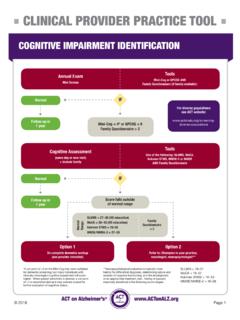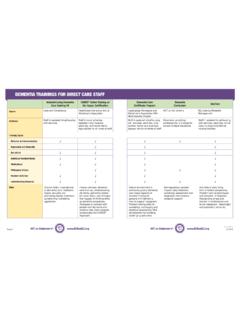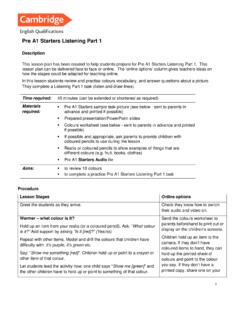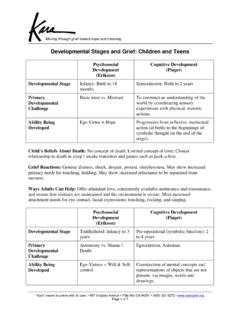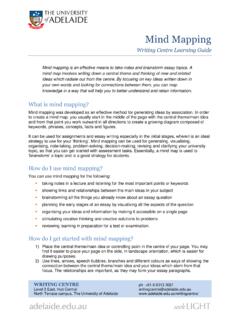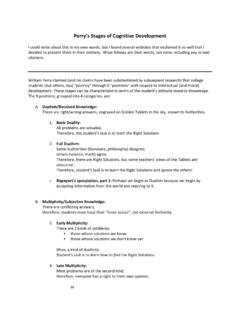Transcription of Stages of Group Development - ACT on Alz
1 1 Stages of Group Development Shared by Mary Ann G. Hennen, Extension Center for Community Vitality, 10-21-14 Most groups have predictable Development , a finding based on four decades of study of Group Development . Bruce Tuckman has developed one of the most well-referenced models in which there are five consistent Stages of Group Development : forming, storming, norming, performing, and adjourning. Most groups progress through these Stages . Each stage builds on the previous stage and prepares the Group for performing. Even with a compelling model, remember a few cautions: Some recent studies suggest that groups manifest behaviors from several Stages at once. Groups may return to earlier Stages when some event takes place that disturbs the equilibrium of the Group ( , new Group members, changing of the Group s goals or procedures). Many groups get stuck in one stage . Research in Fortune 500 companies shows, for example, that only 29 percent of teams reach the performing stage .
2 Reaching the performing stage requires constant attention to maintenance (internal Group processes) as well as task (the content or production) functions. Tuckman Stages of Group Development Overview stage 1 FORMING: Forming the Group ; setting ground rules; finding similarities. stage 2 STORMING: Dealing with issues of power and control; surfacing differences. stage 3 NORMING: Managing Group conflict; finding Group norms; resurfacing similarities. stage 4 PERFORMING: Functioning as an effective Group . stage 5 ADJOURNING: Finding closure. When members of a Group first meet, typical questions they might have are: Why am I here? Who are all of these other people? What are we supposed to accomplish? What s expected of me? What kinds of behavior are appropriate? 2 stage 1 FORMING Typical Behaviors: - The polite stage ; focus on getting acquainted and feeling comfortable. - Conflict is low, suppressed; need for approval high.
3 - Verbal members tend to dominate. - Ability to accomplish Group tasks and stay focused is low. - Little listening ; high distortion of what is heard. - Watchful; guarded; personal feelings kept hidden. - Much giving of/asking for information and data. - Some inclusion/exclusion issues with new and old Group members. Implications for team leaders and facilitators: Use climate-setting activities to break the ice. Help Group members identify and prioritize their goals. Use brainstorming processes to surface hopes, fears, and expectations of members. Identify Group -directed procedures and establish ground rules. Have everyone identify the roles needed and begin defining roles and responsibilities. Help the groups set norms for communicating, resolving conflicts, and presenting ideas. Have the Group reflect on what worked well in the Group and what didn t. stage 2 - STORMING Typical Behaviors: Subgroups and individuals attempt to influence ideas, values, and opinions.
4 Competition for attention, recognition, and influence. People confront each other; interpersonal conflict. Polarization; lack of shared vision. Members may opt out and/or cliques/alliances form. Unsolicited comments; opinions. Sense of feeling struck; frustrated. Emotional reaction to task or misperceptions about task. Process issues discussed outside of meeting. Quick fix: address symptoms, skirt problems. Power inequities, struggle as members jockey for position. Implications for team leaders and facilitators: Try to surface underlying issues and legitimate concerns; encourage the expression of thoughts and feelings. Use collaborative interventions ( , brainstorming, consensus building) and work on defining roles to support collaborative teamwork. Form subtask/problem teams that cut across subgroup boundaries. Focus on major issues with the entire Group . Model reflective listening and coach members on the skills.
5 Reinforce respectful listening and communications during Group discussion. Expect conflict. Encourage Group members to express their frustrations and anxieties, and then focus on defining and organizing tasks. 3 stage 3 NORMING Typical Behaviors: - Authority/leadership issues discussed and resolved. - Issues, not people, confronted. - Cohesion among Group members begins; subgroups disappear. - Members actively listen to each other. - Appreciation and acceptance of alternative points of view. - Risky issues/process issues brought up in meetings. - Ability to remain focused on task at hand. - Quiet people now contributing more in the Group . - Values and assumptions begin to get discovered and discussed. - Relevant questions are asked. - Air of complacency may develop. - Individuals move beyond blame to responsibility. Implications for team leaders and facilitators: Identify the hidden norms and invite the Group to evaluate them or set new norms.
6 Assist the Group to develop a positive Group identity via teambuilding activities. Challenge the boundaries of the Group : bring in outsiders and /or newcomers periodically. Redefine or reestablish goals by focusing on desired results. Coach the Group to use problem-solving methods wisely ( , nominal Group , data dump). Use consensus-building interventions and explore areas of actual difference. Encourage open communication when members close up and appear reluctant to share. Invite input when people are reluctant to address issues that might result in conflict. stage 4 PERFORMING Typical Behaviors: - Members try new behaviors and accept new ideas. - Members relate with honesty, respect, authenticity. - Problems and difficult issues are dealt with, handled creatively. - Diversity is affirmed and welcomed. - Member resourcefulness is utilized to energize each other. - Decision-making process to be used is understood. - Frequent review of process issues.
7 - Clarity on how members experience each other. - Outside help/resources welcomed. - Differences bridged with integrity. - Commitment to work toward common goals. Implications for team leaders and facilitators: Use problem-solving and consensus-building processes to facilitate Group work. Do nothing, join in and comment on what s going well. Experiment with Group structures and explore process improvements. Help the Group critique itself. Your role as leader becomes less active. Arrange appropriate ceremonies/rituals for celebration of accomplishments. Use or suggest inclusion activities that give new members a sense of acceptance. 4 2014 Regents of the University of Minnesota. All rights reserved. University of Minnesota Extension is an equal opportunity educator and employer. In accordance with the Americans with Disabilities Act, this material is available in alternative formats upon request. Direct requests to 612-624-1222.
8 Printed on recycled and recyclable paper with at least 10 percent postconsumer waste material. stage 5 ADJOURNING Typical Behaviors: - The sense of the Group is that the work is done. - May be apprehension over the impending loss of Group identity and friendships. - Cleaning up the Group s undone tasks and removing symbols of the Group . - Evaluating the results and producing final reports. - Saying goodbye. Implications for team leaders and facilitators: Establish closing procedures with the Group . Help design closing ritual or ceremonies. Discuss endings with members and encourage them to talk about how they feel. Provide a vehicle for people to say what they appreciate about each other. End with a celebration that honors the Group and its members. Adapted by Lisa Hinz, LCE Extension Educator from: Facilitation Resources: Volume 4. Managing Group Interactions, (1999) University of Minnesota Extension Service and Hubert H Humphrey Institute of Public Affairs, University of Minnesota.
9 Pp. Referenced Source: Terry R. Bacon, High Impact Facilitation, International Learning Works, Durango, CO, 1996, originally from: Tuckman, Bruce. (1965). Developmental sequence in small groups. Psychological bulletin, 63, 384-399 Tuckman, B. W. & Jensen, M. A. (1977) Stages of small- Group Development revisited. Group Org. Studies 2:419-27.
